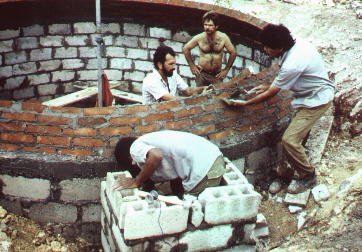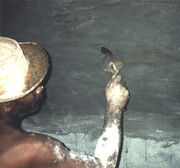Knowledge fuels change
For over a decade, Energypedia has shared free, reliable energy expertise with the world.
We’re now facing a serious funding gap.
Help keep this platform alive — your donation, big or small, truly matters!
Thank you for your support
Difference between revisions of "Material for Biogas Digesters"
***** (***** | *****) m |
***** (***** | *****) m |
||
| Line 1: | Line 1: | ||
| + | |||
= Overview = | = Overview = | ||
| − | In general terms, digesters consist of the digestion tank as such, which is thermally insulated, plus a heating system, mixer systems and discharge systems for sediments and the spent substrate. | + | In general terms, [[Agitation_of_Digesters|digesters]] consist of the digestion tank as such, which is thermally insulated, plus a heating system, mixer systems and discharge systems for sediments and the spent substrate.Two relevant forces act on the digester. The external active earth pressure causes compressive forces within the masonry. The internal hydrostatic and gas pressures causes tensile stress in the masonry. Thus, the external pressure applied by the surrounding earth must be greater at all points than the internal forces. Round and spherical shapes are able to accept the highest forces and distribute them uniformly. Edges and corners lead to peak tensile stresses which can result in cracking. No matter which design is chosen, the digester (fermentation tank) must meet the following requirements: |
<br/> | <br/> | ||
| Line 110: | Line 111: | ||
A further suitable material for use in the construction of biogas systems is wood. It is often used for building liquid-manure hoppers and spreaders. Wooden digesters require a vapor-proof membrane to protect the insulation. Closed vessels of any appreciable size are very hard to render gas-tight without the aid of plastic sheeting. Consequently, such digesters are very rare. | A further suitable material for use in the construction of biogas systems is wood. It is often used for building liquid-manure hoppers and spreaders. Wooden digesters require a vapor-proof membrane to protect the insulation. Closed vessels of any appreciable size are very hard to render gas-tight without the aid of plastic sheeting. Consequently, such digesters are very rare. | ||
| + | |||
| + | = Further Reading = | ||
| + | |||
| + | *[[Biogas|Biogas]]<br/> | ||
| + | *[[Benefits_and_Impacts_of_Biogas_Technology|Benefits and Impacts of Biogas Technology]]<br/> | ||
| + | *[[Biogas_-_Costs_and_Benefits|Biogas - Costs and Benefits]]<br/> | ||
<div><br/></div> | <div><br/></div> | ||
[[Category:Biogas]] | [[Category:Biogas]] | ||
Revision as of 10:31, 17 July 2014
Overview
In general terms, digesters consist of the digestion tank as such, which is thermally insulated, plus a heating system, mixer systems and discharge systems for sediments and the spent substrate.Two relevant forces act on the digester. The external active earth pressure causes compressive forces within the masonry. The internal hydrostatic and gas pressures causes tensile stress in the masonry. Thus, the external pressure applied by the surrounding earth must be greater at all points than the internal forces. Round and spherical shapes are able to accept the highest forces and distribute them uniformly. Edges and corners lead to peak tensile stresses which can result in cracking. No matter which design is chosen, the digester (fermentation tank) must meet the following requirements:
- Water/gastightness - watertightness in order to prevent seepage and the resultant threat to soil and groundwater quality; gastightness in order to ensure proper containment of the entire biogas yield and to prevent air entering into the digester (which could result in the formation of an explosive mixture).
- Insulation - if and to which extent depends on the required process temperature, the local climate and the financial means; heat loss should be minimized if outside temperatures are low, warming up of the digester should be facilitated when outside temperatures are high.
- Minimum surface area - keeps cost of construction to a minimum and reduces heat losses through the vessel walls. A spherical structure has the best ratio of volume and surface area. For practical construction, a hemispherical construction with a conical floor is close to the optimum.
- Structural stability - sufficient to withstand all static and dynamic loads, durable and resistant to corrosion.
Material for the digester
|
Inside plaster of the gastight section of a fixed dome digester |
Acid resistance, in extreme cases when gas desulphurization with air oxygen up to a pH of 2 in the gas chamber.
Consistency under the hydrostatic pressure at the bottom depending on the container height to to 1,2 - 1,8 bar
Technical tightness with respect to (mbar 15) of the gas pressure in the headspace of the container.
Traditional in-situ concrete wall (Ortbeton)
Stanless steel (V4A, 1.4401, X5CrNiMo17-12-2)
Enameled steel panels
In industrialized countries, most of the new digesters are built of gas-tight concrete or steel. Additives are mixed into the concrete to render it gas-tight. If existing concrete vessels are used, their gas-tightness has to be checked. Often, they have not been built from gas-tight concrete or cracks have formed over time which allow the gas to escape.
It is important to check the digester and piping system for gas-tightness prior to putting the biogas unit in service. If leakage is detected only during operation, the digester has to be emptied, cleaned and plastered again. Rectifying a leakage before the initial filling is a lot cheaper.
In developing countries, digesters are usually masonry structures. The plastering has to be watertight up to the lowest slurry level and gas-tight from the lowest gas level upwards (gas-holder). The plaster has to resist moisture and temperatures up to 60°C reliably. The plaster must be resistant to organic acid, ammonia and hydrogen sulfide. The undercoat must be absolutely clean and dry.
Steel
Steel vessels are inherently gas-tight, have good tensile strength, and are relatively easy to construct (by welding). In many cases, a discarded steel vessel of appropriate shape and size can be salvaged for use as a biogas digester. Susceptibility to corrosion both outside (atmospheric humidity) and inside (aggressive media) can be a severe problem. As a rule, some type of anticorrosive coating must be applied and checked at regular intervals. Steel vessels are only cost-effective, if second-hand vessels (e.g. train or truck tankers) can be used.</span>
Concrete
Concrete vessels have gained widespread acceptance in recent years. The requisite gas-tightness necessitates careful construction and the use of gas-tight coatings, linings and/or seal strips in order to prevent gas leakage. Most common are stress cracks at the joints of the top and the sides. The prime advantage of concrete vessels are their practically unlimited useful life and their relatively inexpensive construction. This is especially true for large digesters in industrialized countries.</span>
Cement plaster with special additives
Good results in water- and gas-tightness have been achieved by adding 'water-proofer' to the cement plaster. For gas-tightness, double the amount of water-proofer is required as compared to the amount necessary for water-tightness. The time between the applications of the layers of plaster should not exceed one day, as the plaster becomes water-tight after one day and the new plaster cannot adhere to the old plaster. The following 'recipe' from Tanzania guarantees gas-tightness, provided the masonry structure has no cracks:</span>
- layer: cement-water brushing;
- layer: 1 cm cement : sand plaster 1 : 2.5;
- layer: cement-water brushing;
- layer: cement : lime : sand plaster 1 : 0.25 : 2.5;
- layer: cement-water brushing with water-proofer;
- layer: cement : lime : sand plaster with water proofer and fine, sieved sand 1 : 0.25 : 2.5;
- layer: cement screed (cement-water paste) with water-proofer.
The seven courses of plaster should be applied within 24 hours.
A disadvantage of cement plaster is their inability to bridge small cracks in the masonry structure as, for example, bituminous coats can do.
Bitumen (several layers)
Bitumen coats can be applied easily and remain elastic over long periods of time. Problems arise in the application as the solvents are inflammable (danger of explosion inside the digester) and a health hazard. Bitumen coats cannot be applied on wet surfaces. The drying of masonry structures requires several weeks, unless some heating device (e.g. a charcoal stove) is placed inside the digester for two to three days. Furthermore, the bituminous coat can be damaged by the up-and-down movement of the slurry.
Bitumen coat with aluminum foil
On the first still sticky bitumen coat, aluminum foil is mounted with generous overlaps. A second layer of bitumen is applied on the aluminum foil. Gas-tightness is usually higher compared to the several layers of bitumen without foil.
Water-thinnable dispersion paint
These paints are free from fire- or health hazards. Most of them, however are not gas-tight and not resistant to moisture. Only those dispersion paints should be used which are explicitly recommended for underwater use and which form a gas-tight film.
Single- and dual component synthetic resin paints
Synthetic resin paints form elastic, gas-tight coats which can resist rather high physical load. They are comparably expensive, their use seems only justified if the coating has to resist mechanical stress. This is usually the case with fixed dome plants. Measurements have given evidence that the masonry structure of a fixed dome stretches, though minimally, after filling and under gas pressure.</span>
Paraffin
Paraffin, diluted with new engine oil, is warmed up to 100 -150°C and applied on the plaster which has been heated up with a flame-thrower. The paraffin enters into the plaster and effects a 'deep-sealing'. If paraffin is not available, simple candles can be melted and diluted with engine</span>
Masonry
Masonry is the most frequent construction method for small scale digesters. Only well-burnt clay bricks, high quality, pre-cast concrete blocks or stone blocks should be used in the construction of digesters. Cement-plastered/rendered masonry is a suitable - and inexpensive - approach for building an underground biogas digester, whereby a dome-like shape is recommended. For domes larger than 20 m digester volume, steel reinforcement is advisable. Masons who are to build masonry digesters have to undergo specific training and, initially, require close supervision.
Construction of the dome for a 30 m3 digester in Cuba
Plastics
Plastics have been in widespread use in the field of biogas engineering for a long time. Basic differentiation is made between flexible materials (sheeting) and rigid materials (PE, GRP, etc.). Diverse types of plastic sheeting can be used for constructing the entire digesting chamber (balloon gas holders) or as a vessel cover in the form of a gas-tight "bonnet".
Sheeting made of caoutchouc (india rubber), PVC, and PE of various thickness and description have been tried out in numerous systems. The durability of plastic materials exposed to aggressive slurry, mechanical stress and UV radiation, as well as their gas permeability, vary from material to material and on the production processes employed in their manufacture. Glass-fibre reinforced plastic (GRP) digesters have proven quite suitable, as long as the in-service static stresses are accounted for in the manufacturing process. GRP vessels display good gas-tightness and corrosion resistance. They are easy to repair and have a long useful life span. The use of sandwich material (GRP - foam insulation - GRP) minimizes the on-site insulating work and reduces the cost of transportation and erection.
Wood
A further suitable material for use in the construction of biogas systems is wood. It is often used for building liquid-manure hoppers and spreaders. Wooden digesters require a vapor-proof membrane to protect the insulation. Closed vessels of any appreciable size are very hard to render gas-tight without the aid of plastic sheeting. Consequently, such digesters are very rare.




















